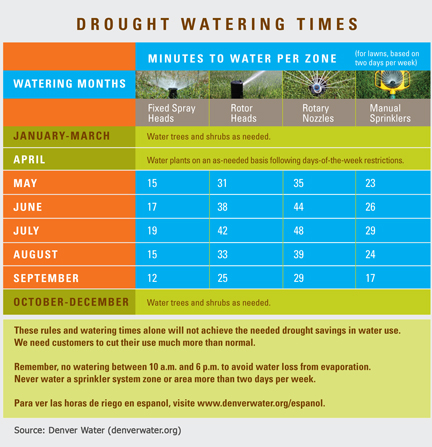by Todd Rutherford
I wanted to revisit Matt’s post on the 20 Best Xeriscape Plants for Colorado, and add to his list of great low-water plants for Colorado landscapes. As with Matt’s initial posting, this list of plants also offers a great variety of color, texture and form for your water-wise garden. Consider adopting some of these amazing plants into your landscape, and tell all your friends about the benefits and beauty of drought tolerant plants.
Perennials:
- Chocolate Flower – Berlandiera lyrata An intoxicating chocolate scent emanates from the yellow blooms of this low water southwestern wildflower from summer into fall.
- Whirling butterflies – Gaura lindheimeri Whirling Butterflies truly lives up to its name. Growing 2-3’ tall by 18-24” wide, this perennial has a significant bloom time, sporting multiple flower stalks that whirl numerous small white flowers in the late summer breezes.
- Creeping Veronica – Veronica spp. A spring blooming favorite, creeping veronicas are somewhat adaptable to light and moisture conditions. The deep green foliage is often evergreen in winter and makes a nice backdrop to the abundant light blue to purple flowers that arrive in April.
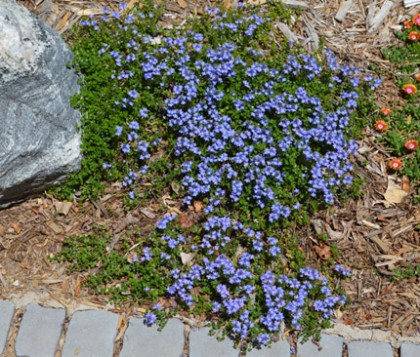
Creeping Veronica
- Sweet Woodruff – Gallium odoratum No dry shade garden should be without this fabulous groundcover. If you have a dry shady spot under a tree, this is the plant for you. It is said that sweet woodruff is one of the few plants that will flourish under the shady canopy of evergreen trees. Small bright green leaves become decorated with tiny white flowers in late spring.
- Orange Carpet Hummingbird Flower – Epilobium canum garrettii If hummingbirds pass through your area consider this California native. It provides a stunning orange floral display in late summer that hummingbirds love, and is ideal to let cascade down a rock wall.
- Blanketflower – Gaillardia aristata Related to sunflowers, this is another North American native that is a great addition to the low-water garden. It blooms from June to September with flower petals that transition from yellow to orange to red. Many cultivars available. Easy to start from seed.
- Silvery Horehound – Marrubium rotundifolium This native of Turkey is a great xeriscape ground cover. It grows 2-4” high and 2-3’ wide. Soft white hairs on the round leaf margins add an effulgent look to the plant.
- Hens and Chicks – Sempervivum spp. This familiar garden succulent from Europe is a hardy performer that will grow just about anywhere. Great for the small spots between other low perennials or rock gardens in full sun. Another nice benefit is how easy it is to transplant the offshoots they provide. Several types are available, with some covered in charming white hairs.
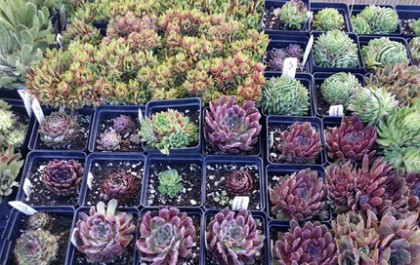
Variety of Sempervivum, a.k.a. Hens and Chicks
- Sunrose – Helianthemum This hardy low-growing perennial provides a delightful floral display starting in June. The profuse blooms hover over a thick mass of low branches that carry small, oval shaped leaves. The flower color is available in shades of red, orange, yellow, pink and white. Perfect for a rock garden or a hot and sunny border area.
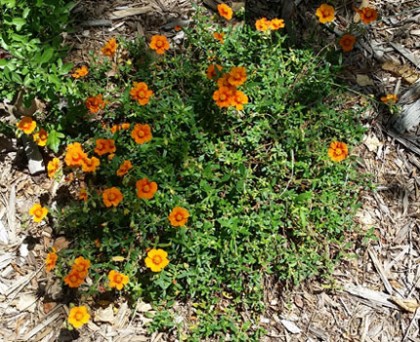
Orange Sunrose
Grasses:
- Blonde Ambition – Bouteloua gracilis ‘Blonde Ambition’ This is a wonderful medium sized grass, 30-36” high and 30-36” wide. It provides multiple seasons of interest, showcasing the classic blue grama grass curled seed heads well into winter.
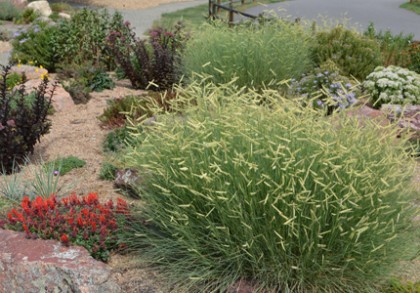
‘Blonde Ambition’ Blue Grama Grass
- ‘Undaunted’ Ruby Muhly – Muhlenbergia reverchonii A 2014 Plant Select introduction. Discovered by Lauren and Scott Ogden, it hails from Oklahoma and Texas. The inflorescence (aka flower cluster) is composed of clouds of tiny pinkish flowers, creating a pink glow with back lighting.
Shrubs:
- Currant – Ribes spp. Currants are medium sized shrubs that grow well in sun, and some species also grow well in filtered shade. This is a notable fact, as many shrubs that do well in part shade require more water than the currants do. Some species provide edible fruit, and some have fragrant flowers. The most notable fragrant currant is Crandall Clove Currant, whose flowers do indeed smell like cloves.
- Dwarf Russian Almond – Prunus tenella Native to Eurasia, this flowering shrub is said to be hardy to zone 2!!! Abundant with pink flowers in the spring, one disadvantage of this shrub is the aggressive suckering habit which may make it hard to control, but this also makes it an attractive cover for wildlife. Size is 3-5’ x 3-5’.
- Dwarf Pinyon Pine – Pinus edulis This slow growing selection of pinyon pine was introduced by Plant Select in 2014. Grows 20-30” height by 20-30” width in 10 years.
- Mohican Viburnum – Viburnum lantana ‘Mohican’ Another great low water shrub that does well in either full or part sun, this viburnum grows 6’ by 6’. White flowers in spring precede orange to red fruits that darken to black in fall.
- Mountain Mahogany – Cercocarpus spp. This western native is indispensable if you’re planning on creating a large native style landscape. Some species are semi-evergreen and one species Cercocarpus montanus the leaves turn a nice russet color in fall. Seeds provide a charming fuzzy appearance that looks great when backlit.
- Peashrub – Caragana spp. A tough shrub from Siberia and China, the peas shrub is, just as the name indicates, related to peas. It produces edible (but not palatable) pods and edible yellow flowers that interest to salads. There are several different species and cultivars to choose from, which range in size from medium to large.
Trees
- Bigtooth Maple – Acer grandidentatum Native to the inter-mountain West, and closely related to the sugar maple. Often growing as multi-stem, it likes full sun to partial shade and low to medium water. The samaras, or winged seeds turn rose color in late summer, and the fall foliage ranges from yellow to red. Grows 20-30’ high by 20-30’ wide.
- Desert Willow – Chilopsis linearis Another typically multi-stem small tree, it is hardy to zone 7 (0 to 5 deg F), but usually survives Denver winters, dying back to the ground each winter, and quickly sprouting new growth each summer. If given a sheltered spot, it may not die back to the ground. Distinctive pink to burgundy flowers with yellow throats. Drought tolerant, with watering being deep and infrequent. Grows 6-30’ high by 6-30’.
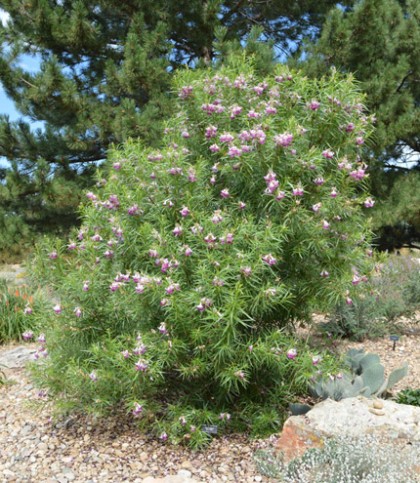
Desert Willow
- Hawthorn – Crataegus spp. These flowering trees are cousins of roses, and bloom in spring with clusters of white flowers that produce long lasting red fruits that offer winter interest. Several species and cultivars have thorns on the branches. Grows 15-25’ high by 15-25’ wide, depending on species and cultivar.
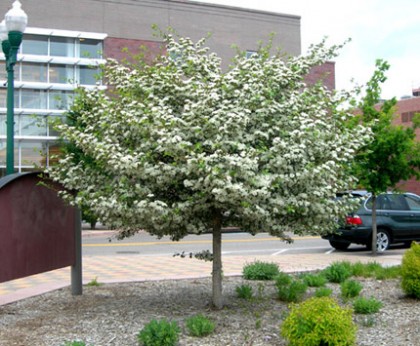
Hawthorn
The Criteria for this List:
– This list is for the Front Range of Colorado. We are somewhere in the middle of zone 4 to 5 on the USDA Plant Hardiness Zone Map.
– I have only included plants that are very easy to care for, and have excluded plants that require a lot of water since that is a key component of Xeriscape. The “best” plants, in my opinion, are those that are well adapted to the local climate and do not require much additional water and maintenance. Of course there are occasions where the use of higher water-use plants is desirable, such as in drainage areas, however I have left them off of this particular list.
This is the official blog of Outdoor Design Group, Colorado Landscape Architects. For more information about our business and our services, click here.
Related Posts:
by Todd Rutherford
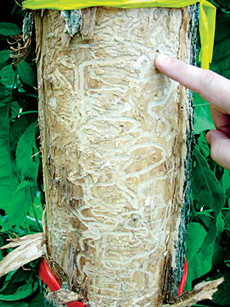
Green Ash tree killed by Emerald Ash Borer
2013 brought tragic news to urban tree enthusiasts in Colorado. In September 2013 the emerald ash borer was found in Boulder County. This find means that thousands of trees along Colorado’s Front Range could be decimated by this pest. And as Colorado State University Professor of Entomology Whitney Cranshaw tells us, the spread of the emerald ash borer (EAB) is dependent upon human activity. It is likely that EAB came to the United States via humans transporting contaminated wood crates from Asia, and it probably reached Colorado through contaminated firewood.
The emerald ash borer, Agrilus planipennis, is a beetle native to Asia. It is small, about the size of a grain of rice. Being a non-native insect in North America, it has no predators to keep its population in check. And unlike the Ash trees in Asia, our native Ash trees don’t possess the natural insecticides that control EAB. Adult borers eat leaves of Ash trees, then mate and lay eggs in crevices in the bark. The eggs hatch, releasing larvae which burrow beneath the bark, which disrupts the trees nutrient and water supplying layers. The tree becomes riddled with tunnels the larvae leave behind. The larvae then hatch in spring, burrowing their way to the surface, where they repeat the cycle of feeding on the leaves, breeding and laying eggs of new generation. They kill the canopy of the tree, limb by limb, with the entire tree dead in 3-5 years.
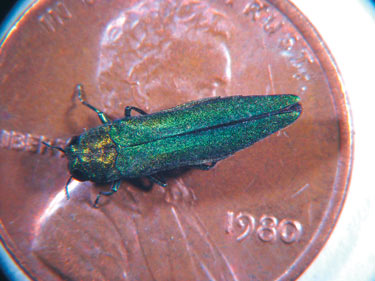
Adult EAB on a penny.
Colorado’s department of Agriculture estimates that there are 1.45 million ash trees in just the Denver Metro area alone. The costs to spray so many trees will quickly mount.
Tree and insect experts agree that there is no point in spraying your Ash tree unless the tree is currently infested. “Since most EAB treatments provide control for one year or, at most, two years following application there is no benefit in treating a tree prior to when EAB is present”, Cranshaw writes in a recent report from Colorado State University.
In other words there is no treatment that will stop the EAB from attacking your Ash tree. Spraying before the tree is infested only wastes money and needlessly adds dangerous chemicals to the environment. In fact, many entomologists warn that even spraying an infested tree may have lethal impacts on beneficial insects such as bees and butterflies, and won’t completely rid your tree of EAB, and would probably only buy you a few extra years of life of an infested Ash tree.
If we take a serious look at the situation, spraying at all is mostly a futile and dangerous endeavor. Spraying gives tree care companies extra income but endangers the life of beneficial insects, could possibly have harmful effects on people and is very unlikely to ultimately save your Ash tree. As CSU’s Cranshaw has said, he expects in 5-10 years all Ash trees in the Metro Denver area to be infested by EAB. Furthermore, Cranshaw writes: “Once established at a location emerald ash borer can be expected to survive in the area as long as any ash trees remain. Therefore some management of emerald ash borer will be required for as long as one wishes to maintain the tree”. It is our opinion that a better strategy to dealing with EAB is planning for the eventual replacement of your Ash tree, rather than treating your ash tree with toxic chemicals, year after year.
What can we do to slow the spread of EAB to the rest of Colorado?
1.) Do not transport any ash wood in or out of your area.
2.) Do not plant more Ash trees in Colorado.
If you have an Ash tree, you really should consider planting a replacement tree now. If you are unsure about what type of tree would be a good alternative to Ash, contact your local nursery, arborist, or contact us and we can help you with that decision.
This is the official blog of Outdoor Design Group, Colorado Landscape Architects. For more information about our business and our services, click here.
Related Posts:
by Todd Rutherford
As you are all probably aware, we live in a semi-arid climate in Colorado. Unless you have a landscape comprised entirely of native plants, you need to be cognizant of the occasional need for winter watering to maintain healthy landscape plants. This can be a challenge due to the fluctuating temperatures we experience. And unless you want to re-winterize your irrigation system each time you winter water, you likely will be watering by hand.
Generally speaking, if there has been no natural precipitation for a month and the temperatures have been above normal for your region, trees and shrubs planted within the last year will benefit from receiving supplemental 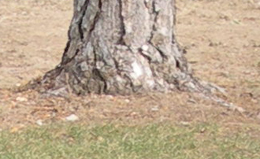 water. Only water when the air and soil temperatures are greater than 40 degrees Fahrenheit, with no snow cover. Plants that are on the south or west side of your house are more likely to dry out before those on the east or north. And plants that get reflected heat from buildings, walls and fences or that are in windy sites are more likely to dry out more quickly.
water. Only water when the air and soil temperatures are greater than 40 degrees Fahrenheit, with no snow cover. Plants that are on the south or west side of your house are more likely to dry out before those on the east or north. And plants that get reflected heat from buildings, walls and fences or that are in windy sites are more likely to dry out more quickly.
Recently planted deciduous trees are most in danger from winter dry spells. Established trees are somewhat immune from winter drought, unless the dry spell is extreme. If you are uncertain if your tree is established, observe this advice from Colorado State University Extension Service: “Trees generally take one year to establish for each inch of trunk diameter. For example, a two inch diameter (caliper) tree takes a minimum of two years to establish under normal conditions.“ Water the newer and younger trees once a month with 10 gallons of water per each trunk diameter, measured at 6 to 12” above the ground. Let the water soak in slowly to a depth of 12”.
Similarly, recently planted shrubs are more susceptible to dry winter conditions than more established shrubs. For new shrubs, water them with 5 gallons, two times per month. Small established shrubs need 5 gallons once per month. Large established shrubs need about 18 gallons per month.
Newly planted evergreen trees and shrubs are also very sensitive to winter drought, because they don’t drop their leaves or needles so they still are transpiring moisture through the needles all year long. Some arborists recommend misting the leaves/needles with water rather than focusing on the soil. Some of the water will trickle down and get into the soil. Consider doing this 3 times a month for those new evergreens. This should help your evergreens avoid the brown damaged needles that occur during drought stress. Evergreens that need special attention during winter drought are spruce, fir, arborvitae, yew, Oregon grape-holly, boxwood, and Manhattan euonymus.
Obviously, if we receive enough precipitation, no supplemental watering is needed. The rule of thumb here is if snow still covers the ground or if there was a significant snow fall (6” or more) at least once in the last month, you probably don’t need to water that month. But if we have a dry spell and you’ve not properly watered your landscape plants, they may become weakened, making them prone to insects and disease.
If you have a recently planted lawn, consider giving it ½” of water per month during winter dry spells. Established lawns shouldn’t need supplemental watering because bluegrass goes dormant in winter.
Do not neglect to properly mulch all your trees, shrubs and perennials. This will help to keep your plants from further drying out.
Once you have watered your landscape plants, don’t forget to unhook your hose from the hose bib so as to avoid frost damage to the pipes once temperatures drop back down below freezing.
This is the official blog of Outdoor Design Group, Colorado Landscape Architects. For more information about our business and our services, click here.
Related Posts:
by Matt Corrion
1) Ditch the bluegrass turf lawn, completely or partially. Bluegrass turf uses far more water than alternative landscaping choices.
2) Set your mower on its highest setting so turf grass is not cut too short. Longer grass keeps the soil cooler and reduces evaporation.
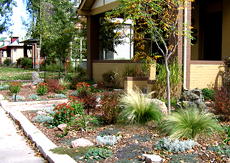
Consider redesigning your landscape so it requires less water and looks more interesting
3) Use the mulch setting on your lawn mower so grass clippings stay on the lawn, which helps slow evapotranspiration and provides nutrients to the soil.
4) Do not install bluegrass turf on slopes, especially south facing slopes, because much of the water will run off the slope and sprinklers will need to run for longer times to compensate. Instead consider planting shrubs or native plants with drip irrigation on a slope.
5) Mulch your trees, shrubs and perennials to reduce water use. Mulch slows down the evaporation of soil moisture, reduces water run-off, and reduces weeds which can steal moisture from your plants.
6) Consider replacing your existing high-water turf lawn with low-water turf options such as buffalo grass, blue grama grass or a fescue grass.
7) Plant native plants that are more appropriate for the climate you live in.
8) If you plant non-native plants, use ones that are adapted to your climate conditions, such as iceplant from South Africa, and Russian sage from Central Asia.
9) Place your plants in groups organized by water use, so as to avoid overwatering low water need plants.
10) Plant trees in your turf lawn to provide shade for the lawn and reduce evapotranspiration of the grass.
11) Follow your water provider’s summer watering rules, and any watering restrictions that may be in place at that time.
12) Don’t water during the hottest time of the day. It is best to water between 6 pm and 10 am. Watering during the hottest time of the day increases the evaporation of the water before it reaches the roots of your plants.
13) Don’t water when it is windy. Just as watering during the hottest time of day increases water loss due to increased evaporation, so does watering when it is windy.
14) When shoveling snow in winter, place snow piles where it will melt and water trees and shrubs that can benefit from extra moisture in winter.
15) Install a rain sensor to avoid having your irrigation system run when it is raining, or the day after a heavy rainfall event.
16) If you don’t have an automatic irrigation system, use a mechanical or digital timer with your sprinklers.
17) If you have an automatic irrigation system, check it once a month or more often to fix any leaks or problems that may occur.
18) Use drip irrigation to water your landscape plants. Drip irrigation is the most efficient form of irrigation because the water is not sprayed into the air which increases evaporation of the water before it reaches the plants.
19) Avoid placing sprinkler heads against fences and hardscape. Instead, install a strip of rock mulch between fences / hardscape and sprinkler heads. In addition to reducing water waste, this minimizes water damage and the need for turf edge trimming.
20) Improve your soils water holding capacity by amending the soil with organic matter.
21) Make your landscape more permeable to keep storm water on your property. Instead of a solid concrete patio, install a unit paver patio to allow water to percolate down rather than running off.
22) Divide watering times into shorter shifts to improve water absorption, and avoid runoff. This is sometimes referred to as the “cycle and soak” method.
23) Direct gutter downspouts to planted areas rather than streets or storm water areas.
24) Save rainwater from your roof for irrigating plants.
25) Save indoor “grey” water for irrigating trees and shrubs.
26) If local codes allow, hire a plumber (or DIY) to pipe your grey water to your landscaping.
27) Use a mild/natural dish soap for washing dishes to keep this grey water safer for your landscape plants.
28) Bathe your pets outside over turf areas that need water, using mild/natural soap.
29) Wash fruits and vegetables outside over your lawn to allow wash water to irrigate the turf.
30) Plant trees (adapted for your climate) to shade your turf area to reduce evapo-transpiration of the turf.
31) Consult a landscape architect or horticulturalist to learn the best plants to use in your climate and growing zone.
32) Before planting certain species of plants, do extensive soil preparations. Some plants benefit from additional organic matter, while others will perform better if drainage is improved.
33) Save fallen leaves in autumn and use as a mulch around trees, shrubs and perennials.
34) Plant new perennials, shrubs and trees in fall when temperatures are cooler because it will take less water to establish them, as compared to planting in early summer.
35) Cover water features, pools and spas when not in use to reduce evaporation.
36) Check water features, pools and spas for leaks.
37) Consider using pondless water features, where the water reservoir is hidden or obscured which provides less evaporation that a typical pond.
38) Don’t use water to clean paving. Use a broom and dust pan.
39) If you want to install a water feature, choose one that cascades or trickles rather than one that sprays in the air. Spraying fountains lose more water to evaporation.
40) If your children want to play in the sprinkler, have them do this in an area of your lawn that needs water.
41) Do not let your children waste water by spraying sprinklers on sidewalks, drive ways or the street.
42) Place large rocks near shrubs, trees or perennials to keep the soil below the rock cool and moist.
43) When refreshing your pet’s water dish, don’t discard the old water in the sink, pour it on plants outside.
44) If you have ice or water left in a take-out cup, or in re-usable glasses, pour it on your landscape plants outside.
45) Don’t discard used ice and water from a cooler in the sink, but throw them outside on your plants.
46) If you wash your car at home with a hose, use a shut-off nozzle so water is not running in between soaping and rinsing the car.
47) Wash the car in a lawn area so that you water the grass at the same time. Use a mild/natural detergent when doing this.
48) Don’t use a hose to clean out your gutters. Consider using a leaf blower or a long handled rake specifically made for the job.
49) Replace old spray nozzles on your irrigation system with newer, more efficient rotary nozzles. They reduce runoff and evaporation. Your purchase and installation of these nozzles may make you eligible for rebates from your water provider. Contact them for more details.
50) Consider hiring a landscape architect to analyze your property and re-design it to require less water and maintenance.
This is the official blog of Outdoor Design Group, Colorado Landscape Architects. For more information about our business and our services, click here.
Related Posts:








 water. Only water when the air and soil temperatures are greater than 40 degrees Fahrenheit, with no snow cover. Plants that are on the south or west side of your house are more likely to dry out before those on the east or north. And plants that get reflected heat from buildings, walls and fences or that are in windy sites are more likely to dry out more quickly.
water. Only water when the air and soil temperatures are greater than 40 degrees Fahrenheit, with no snow cover. Plants that are on the south or west side of your house are more likely to dry out before those on the east or north. And plants that get reflected heat from buildings, walls and fences or that are in windy sites are more likely to dry out more quickly.
